Thermally Controlled Synthesis of Octahedral Rhenium Clusters with 4,4′-Bipyridine and CN− Apical Ligands
Abstract
:1. Introduction
2. Experimental Section
3. Results and Discussion
3.1. Synthesis
3.2. Luminescence
3.3. Crystal Structures
3.4. Electronic Structure
3.5. Redox Behavior of [Re6S8(bpy)2(CN)4]2− Cluster Anions
4. Conclusions
Author Contributions
Funding
Data Availability Statement
Conflicts of Interest
References
- Costentin, C.; Robert, M.; Savéant, J.-M. Molecular catalysis of electrochemical reactions. Curr. Opin. Electrochem. 2017, 2, 26–31. [Google Scholar] [CrossRef]
- Dalle, K.E.; Warnan, J.; Leung, J.J.; Reuillard, B.; Karmel, I.S.; Reisner, E. Electro- and Solar-Drien Fuel Synthesis with First Row Transition Metal Complexes. Chem. Rev. 2019, 119, 2752–2875. [Google Scholar] [CrossRef] [PubMed]
- Starikova, A.A.; Minkin, V.I. Adducts of transition metal complexes with redox-active ligands: The structure and spin-state-switching rearrangements. Russ. Chem. Rev. 2018, 87, 1049–1079. [Google Scholar] [CrossRef]
- Cameron, J.M.; Holc, C.; Kibler, A.J.; Peake, C.L.; Walsh, D.A.; Newton, G.N.; Johnson, L.R. Molecular redox species for next-generation batteries. Chem. Soc. Rev. 2021, 50, 5863–5883. [Google Scholar] [CrossRef]
- Cordier, S.; Molard, Y.; Brylev, K.A.; Mironov, Y.V.; Grasset, F.; Fabre, B.; Naumov, N.G. Advances in the Engineering of Near Infrared Emitting Liquid Crystals and Copolymers, Extended Porous Frameworks, Theranostic Tools and Molecular Junctions Using Tailored Re6 Cluster Building Blocks. J. Clust. Sci. 2015, 26, 53–81. [Google Scholar] [CrossRef] [Green Version]
- Long, J.R.; McCarty, L.S.; Holm, R.H. A Solid-State Route to Molecular Clusters: Access to the Solution Chemistry of [Re6Q8]2+ (Q = S, Se) Core-Containing Clusters via Dimensional Reduction. J. Am. Chem. Soc. 1996, 118, 4603–4616. [Google Scholar] [CrossRef]
- Naumov, N.G.; Ostanina, E.V.; Virovets, A.V.; Schmidtman, M.; Müller, A.; Fedorov, V.E. 23-Electron Re6 metal clusters: Syntheses and crystal structures of (Ph4P)3[Re6S8(CN)6], (Ph4P)2(H)[Re6Se8(CN)6]·8H2O, and (Et4N)2(H)[Re6Te8(CN)6]·2H2O. Russ. Chem. Bull. 2002, 51, 866–871. [Google Scholar] [CrossRef]
- Amela-Cortes, M.; Cordier, S.; Naumov, N.G.; Mériadec, C.; Artzner, F.; Molard, Y. Hexacyano octahedral metallic clusters as versatile building blocks in the design of extended polymeric framework and clustomesogens. J. Mater. Chem. C 2014, 2, 9813–9823. [Google Scholar] [CrossRef]
- Szczepura, L.F.; Soto, E. Ligated Transition Metal Clusters in Solid-State Chemistry: The Legacy of Marcel Sergent; Halet, J.-F., Ed.; Springer International Publishing: Cham, Switzerland, 2019; pp. 75–108. [Google Scholar]
- Yoshimura, T.; Umakoshi, K.; Sasaki, Y.; Sykes, A.G. Synthesis, Structures, and Redox Properties of Octa(μ3-sulfido)hexarhenium(III) Complexes Having Terminal Pyridine Ligands. Inorg. Chem. 1999, 38, 5557–5564. [Google Scholar] [CrossRef] [PubMed]
- Yoshimura, T.; Umakoshi, K.; Sasaki, Y.; Ishizaka, S.; Kim, H.-B.; Kitamura, N. Emission and Metal- and Ligand-Centered-Redox Characteristics of the Hexarhenium(III) Clusters trans- and cis-[Re6(μ3-S)8Cl4(L)2]2−, Where L Is a Pyridine Derivative or Pyrazine. Inorg. Chem. 2000, 39, 1765–1772. [Google Scholar] [CrossRef]
- Ulantikov, A.A.; Gayfulin, Y.M.; Ivanov, A.A.; Sukhikh, T.S.; Ryzhikov, M.R.; Brylev, K.A.; Smolentsev, A.I.; Shestopalov, M.A.; Mironov, Y.V. Soluble Molecular Rhenium Cluster Complexes Exhibiting Multistage Terminal Ligands Reduction. Inorg. Chem. 2020, 59, 6460–6470. [Google Scholar] [CrossRef]
- Naumov, N.G.; Ledneva, A.Y.; Kim, S.-J.; Fedorov, V.E. New trans-[Re6S8(CN)4L2]n– Rhenium Cluster Complexes: Syntheses, Crystal Structures and Properties. J. Clust. Sci. 2009, 20, 225–239. [Google Scholar] [CrossRef]
- Kasem, B.K.K.; Jones, S. Platinum as a Reference Electrode in Electrochemical Measurements. Platin. Met. Rev. 2008, 52, 100–106. [Google Scholar] [CrossRef]
- APEX2. Version 2.0; Bruker Advanced X-ray Solutions: Madison, WI, USA, 2000.
- SAINT. Version 8.18c; Bruker Advanced X-ray Solutions: Madison, WI, USA, 2012.
- SADABS. Version 2.11; Bruker Advanced X-ray Solutions: Madison, WI, USA, 2000.
- Sheldrick, G. SHELXT—Integrated space-group and crystal-structure determination. Acta Cryst. A 2015, 71, 3–8. [Google Scholar] [CrossRef] [Green Version]
- Sheldrick, G. Crystal structure refinement with SHELXL. Acta Cryst. C 2015, 71, 3–8. [Google Scholar] [CrossRef] [PubMed]
- Dolomanov, O.V.; Bourhis, L.J.; Gildea, R.J.; Howard, J.A.K.; Puschmann, H. OLEX2: A complete structure solution, refinement and analysis program. J. Appl. Cryst. 2009, 42, 339–341. [Google Scholar] [CrossRef]
- Fonseca Guerra, C.; Snijders, J.G.; te Velde, G.; Baerends, E.J. Towards an order-N DFT method. Theor. Chem. Acc. 1998, 99, 391–403. [Google Scholar] [CrossRef]
- Te Velde, G.; Bickelhaupt, F.M.; Baerends, E.J.; Fonseca Guerra, C.; van Gisbergen, S.J.A.; Snijders, J.G.; Ziegler, T. Chemistry with ADF. J. Comput. Chem. 2001, 22, 931–967. [Google Scholar] [CrossRef]
- Vosko, S.H.; Wilk, L.; Nusair, M. Accurate spin-dependent electron liquid correlation energies for local spin density calculations: A critical analysis. Can. J. Phys. 1980, 58, 1200–1211. [Google Scholar] [CrossRef] [Green Version]
- Perdew, J.P.; Wang, Y. Accurate and simple analytic representation of the electron-gas correlation energy. Phys. Rev. B 1992, 45, 13244–13249. [Google Scholar] [CrossRef]
- Swart, M. A new family of hybrid density functionals. Chem. Phys. Lett. 2013, 580, 166–171. [Google Scholar] [CrossRef]
- Van Lenthe, E.; Baerends, E.J. Optimized Slater-type basis sets for the elements 1–118. J. Comput. Chem. 2003, 24, 1142–1156. [Google Scholar] [CrossRef] [PubMed]
- Pye, C.C.; Ziegler, T. An implementation of the conductor-like screening model of solvation within the Amsterdam density functional package. Theor. Chem. Acc. 1999, 101, 396–408. [Google Scholar] [CrossRef]
- Lenthe, E.; Ehlers, A.; Baerends, E.-J. Geometry optimizations in the zero order regular approximation for relativistic effects. J. Chem. Phys. 1999, 110, 8943–8953. [Google Scholar] [CrossRef] [Green Version]
- Ivanov, A.A.; Shestopalov, M.A.; Brylev, K.A.; Khlestkin, V.K.; Mironov, Y.V. A family of octahedral rhenium cluster complexes trans-[{Re6Q8}(PPh3)4X2] (Q = S or Se, X = Cl, Br or I): Preparation and halide-dependent luminescence properties. Polyhedron 2014, 81, 634–638. [Google Scholar] [CrossRef]
- Ulantikov, A.A.; Gayfulin, Y.M.; Sukhikh, T.S.; Ryadun, A.A.; Ryzhikov, M.R.; Mironov, Y.V. Synthesis, structure and physicochemical properties of molecular rhenium cluster complexes with 4-phenylpyridine molecules as terminal ligands. J. Struct. Chem. 2021, 62, 1009–1019. [Google Scholar] [CrossRef]
- Bardin, V.A.; Ivanov, A.A.; Konovalov, D.I.; Smolentsev, A.I.; Shestopalov, M.A. Crystal structure and luminescent properties of rhenium clusters [{Re6(μ3-Q)8}(imz-[1,2-a]py)6]Br2. J. Struct. Chem. 2020, 61, 1624–1629. [Google Scholar] [CrossRef]
- Konovalov, D.I.; Ivanov, A.A.; Vorotnikov, Y.A.; Brylev, K.A.; Eltsov, I.V.; Kuratieva, N.V.; Kitamura, N.; Mironov, Y.V.; Shestopalov, M.A. Synthesis and luminescence properties of apically homoleptic octahedral rhenium clusters with pyrazole and 3,5-dimethylpyrazole. Inorg. Chim. Acta 2019, 498, 119128. [Google Scholar] [CrossRef]
- Shestopalov, M.A.; Zubareva, K.E.; Khripko, O.P.; Khripko, Y.I.; Solovieva, A.O.; Kuratieva, N.V.; Mironov, Y.V.; Kitamura, N.; Fedorov, V.E.; Brylev, K.A. The First Water-Soluble Hexarhenium Cluster Complexes with a Heterocyclic Ligand Environment: Synthesis, Luminescence, and Biological Properties. Inorg. Chem. 2014, 53, 9006–9013. [Google Scholar] [CrossRef] [PubMed]
- Muravieva, V.K.; Gayfulin, Y.M.; Lappi, T.I.; Dorcet, V.; Sukhikh, T.S.; Lemoine, P.; Ryzhikov, M.R.; Mironov, Y.V.; Cordier, S.; Naumov, N.G. Apical Cyanide Ligand Substitution in Heterometallic Clusters [Re3Mo3Q8(CN)6]n– (Q = S, Se). Eur. J. Inorg. Chem. 2019, 2019, 2685–2690. [Google Scholar] [CrossRef]
- Ledneva, A.Y.; Naumov, N.G.; Virovets, A.V.; Cordier, S.; Molard, Y. Crystal structures of trans-[Re6S8(CN)2L4] complexes, L = pyridine or 4-methylpyridine. J. Struct. Chem. 2012, 53, 132–137. [Google Scholar] [CrossRef]
- Tadokoro, M.; Shiomi, T.; Isobe, K.; Nakasuji, K. Cesium(I)-Mediated 3-D Superstructures by One-Pot Self-Organization of Hydrogen-Bonded Nickel Complexes. Inorg. Chem. 2001, 40, 5476–5478. [Google Scholar] [CrossRef]
- Poturovic, S.; Lu, D.; Heeg, M.J.; Winter, C.H. Synthesis and structural characterization of heavier group 1 methyl tetrazolate complexes: New bridging coordination modes of the tetrazolate ligand. Polyhedron 2008, 27, 3280–3286. [Google Scholar] [CrossRef]
- Dechambenoit, P.; Ferlay, S.; Kyritsakas, N.; Hosseini, M.W. Molecular tectonics: Crystal engineering of mixed valence Fe(II)/Fe(III) solid solutions. Chem. Commun. 2010, 46, 868–870. [Google Scholar] [CrossRef] [PubMed]
- Klapötke, T.M.; Stein, M.; Stierstorfer, J. Salts of 1H-Tetrazole—Synthesis, Characterization and Properties. Z. Anorg. Allgem. Chem. 2008, 634, 1711–1723. [Google Scholar] [CrossRef]
- Rabanal-León, W.A.; Murillo-López, J.A.; Páez-Hernández, D.; Arratia-Pérez, R. Understanding the Influence of Terminal Ligands on the Electronic Structure and Bonding Nature in [Re6(μ3-Q8)]2+ Clusters. J. Phys. Chem. A 2014, 118, 11083–11089. [Google Scholar] [CrossRef]
- Yoshimura, T.; Suo, C.; Tsuge, K.; Ishizaka, S.; Nozaki, K.; Sasaki, Y.; Kitamura, N.; Shinohara, A. Excited-State Properties of Octahedral Hexarhenium(III) Complexes with Redox-active N-heteroaromatic Ligands. Inorg. Chem. 2010, 49, 531–540. [Google Scholar] [CrossRef]
- Tabner, B.J.; Yandle, J.R. A correlation of half-wave reduction potentials with theoretical calculations for some nitrogen-containing heteromolecules in dimethylformamide. J. Chem. Soc. A 1968, 381–388. [Google Scholar] [CrossRef]
- Gabriel, J.-C.P.; Boubekeur, K.; Uriel, S.; Batail, P. Chemistry of Hexanuclear Rhenium Chalcohalide Clusters. Chem. Rev. 2001, 101, 2037–2066. [Google Scholar] [CrossRef]
- Bard, A.J.; Faulkner, L.R. (Eds.) Electrochemical Methods: Fundamentals and Applications, 2 ed.; John Wiley & Sons, Inc.: Hoboken, NJ, USA, 2001. [Google Scholar]
- Janisch, J.; Ruff, A.; Speiser, B.; Wolff, C.; Zigelli, J.; Benthin, S.; Feldmann, V.; Mayer, H.A. Consistent diffusion coefficients of ferrocene in some non-aqueous solvents: Electrochemical simultaneous determination together with electrode sizes and comparison to pulse-gradient spin-echo NMR results. J. Solid State Electrochem. 2011, 15, 2083. [Google Scholar] [CrossRef]
- Tsierkezos, N.G. Cyclic Voltammetric Studies of Ferrocene in Nonaqueous Solvents in the Temperature Range from 248.15 to 298.15 K. J. Solut. Chem. 2007, 36, 289–302. [Google Scholar] [CrossRef]
- Forghani, M.; Donne, S.W. Complications When Differentiating Charge Transfer Processes in Electrochemical Capacitor Materials: Assessment of Cyclic Voltammetry Data. J. Electrochem. Soc. 2019, 166, A1370–A1379. [Google Scholar] [CrossRef]
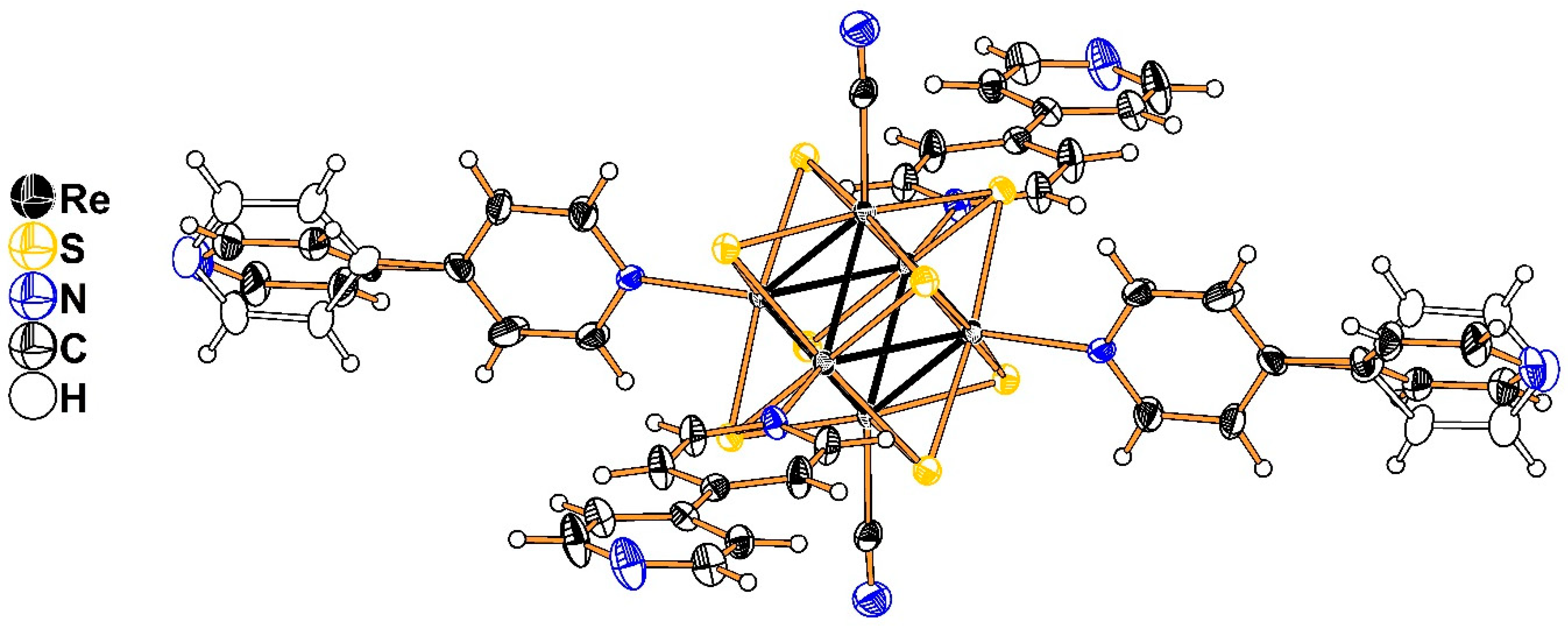
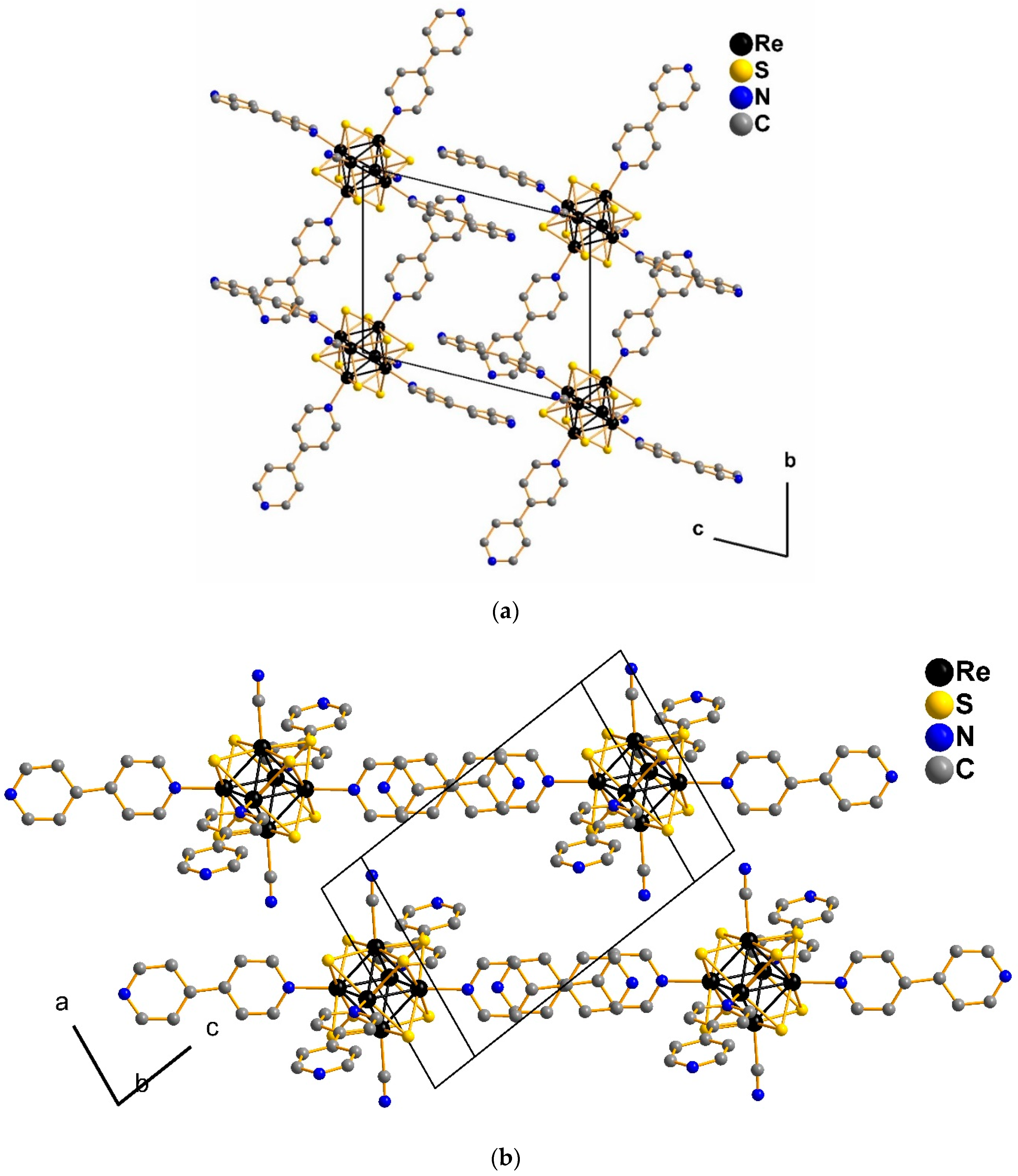
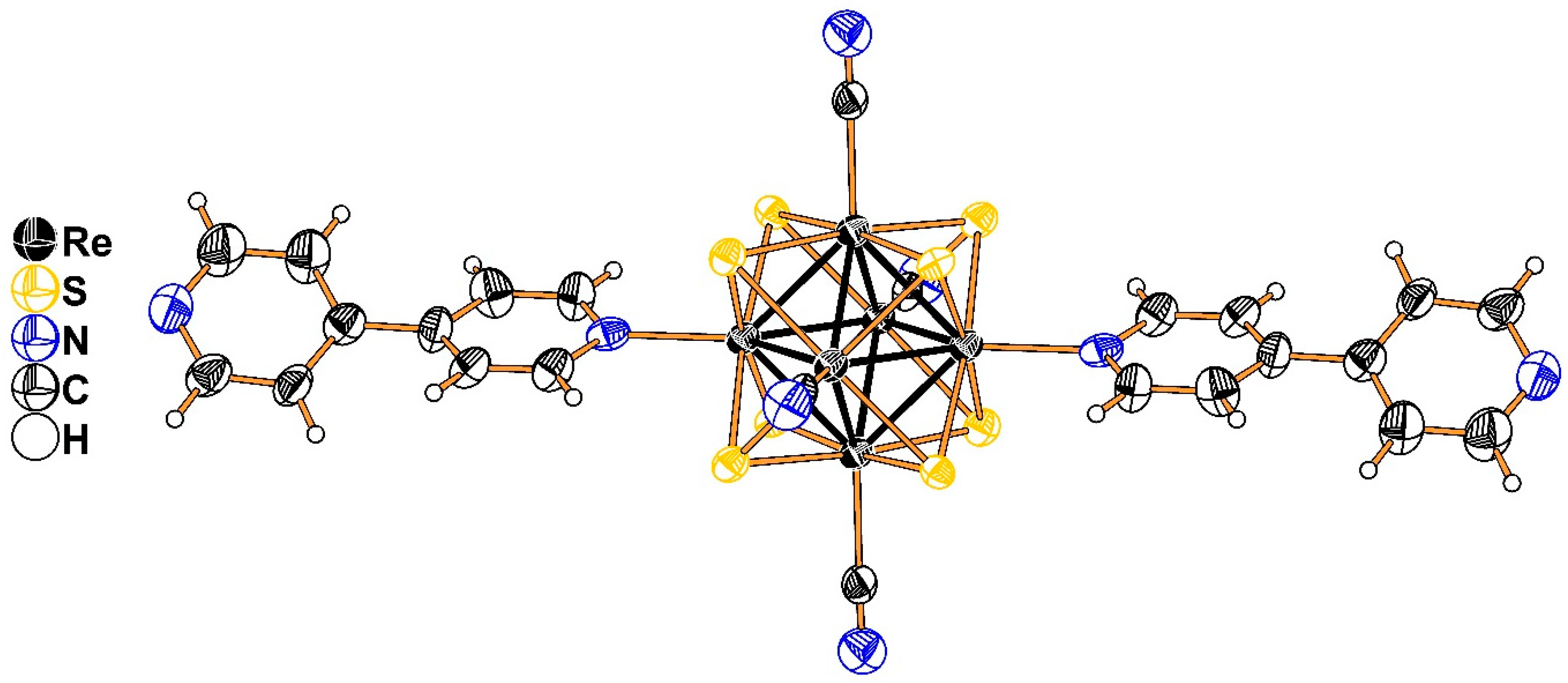
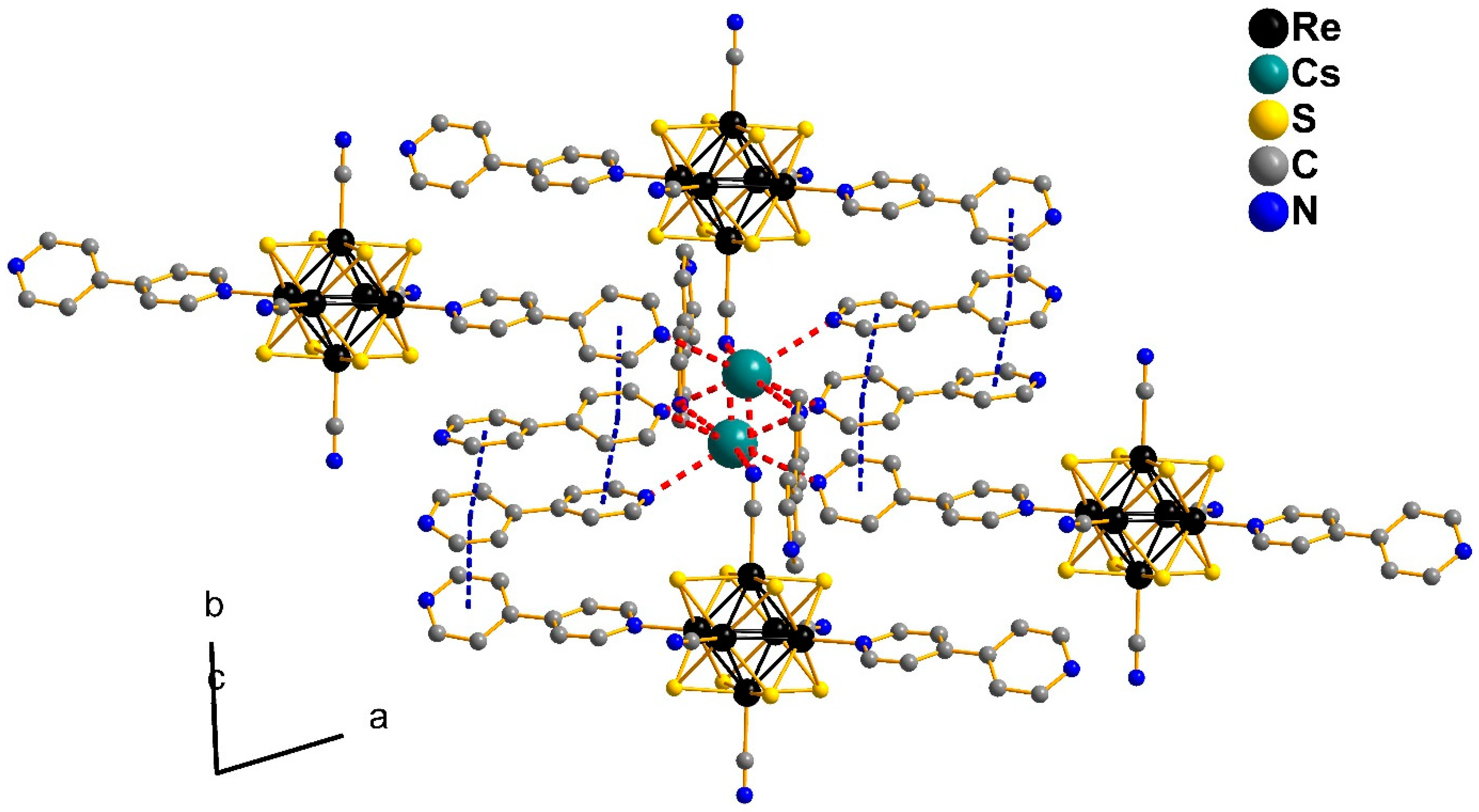
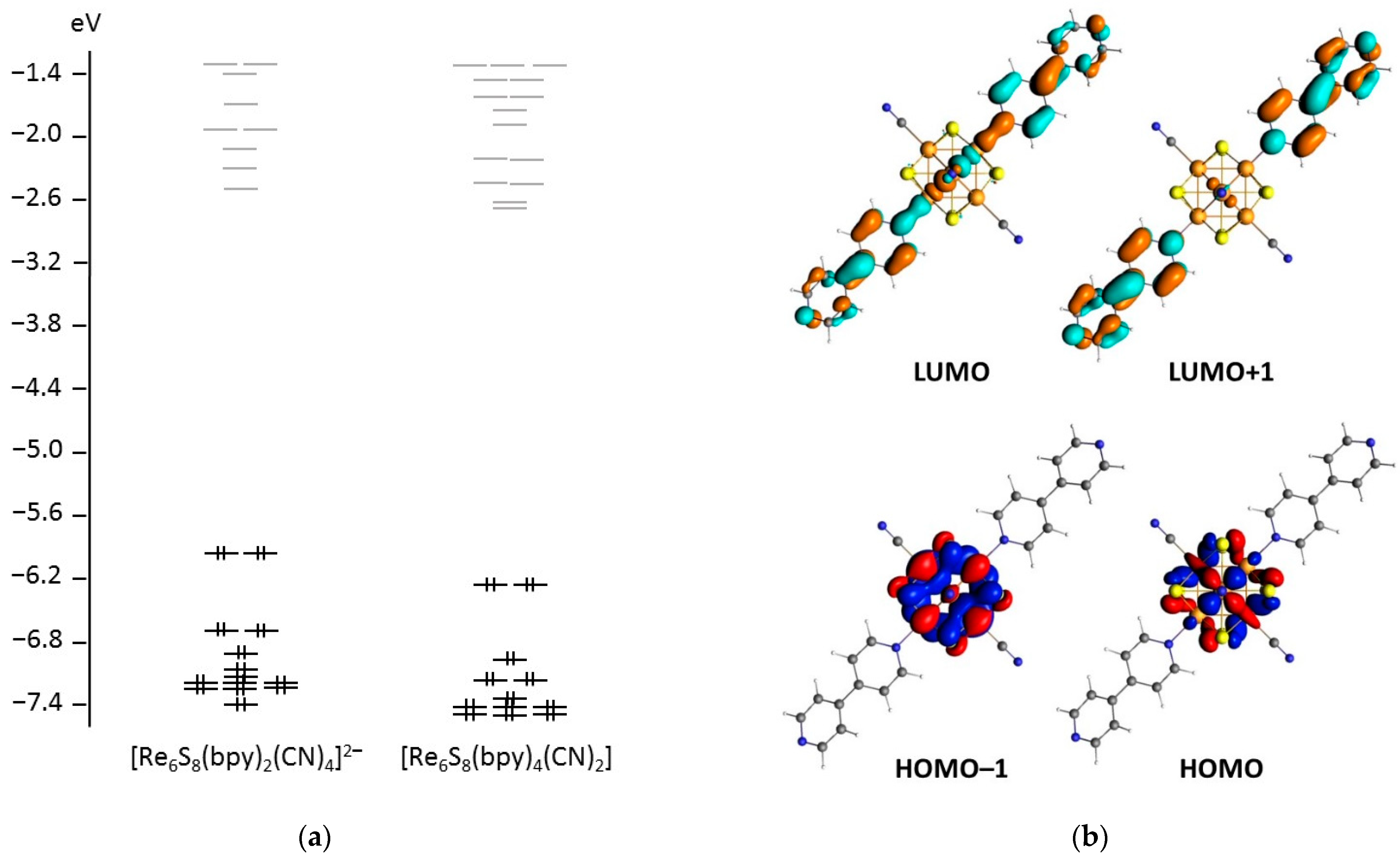


| Compound | 1·bpy | 2·bpy |
|---|---|---|
| Empirical formula | C62H48N14Re6S8 | C104H80N24Re6S8Cs1.7K0.3 |
| Formula weight | 2362.82 | 3273.52 |
| Crystal system, space group | triclinic, P1 | triclinic, P1 |
| a/Å | 10.2446 (3) | 12.9047 (4) |
| b/Å | 11.7046 (4) | 14.3578 (5) |
| c/Å | 14.4547 (4) | 15.6379 (5) |
| α/° | 74.479 (1) | 64.637 (1) |
| β/° | 80.385 (1) | 82.959 (1) |
| γ/° | 75.696 (1) | 75.706 (1) |
| Volume/Å3 | 1608.79 (9) | 2536.64 |
| Z | 1 | 1 |
| ρcalc/g·cm−3 | 2.439 | 2.143 |
| μ/mm−1 | 11.554 | 7.957 |
| F (000) | 1096 | 1548 |
| Crystal size/mm3 | 0.04 × 0.04 × 0.04 | 0.08 × 0.04 × 0.03 |
| 2Θ range for data collection/° | 2.06 to 33.14 | 1.61 to 25.03 |
| Index ranges | −13 ≤ h ≤ 15, −17 ≤ k ≤ 18, −18 ≤ l ≤ 22 | −15≤ h ≤ 15, −17≤ k ≤ 17, −18≤ l ≤ 18 |
| Reflections collected | 37,931 | 26,949 |
| Independent reflections | 12,162 Rint = 0.0416 Rsigma = 0.0492 | 8954 Rint = 0.0409 Rsigma = 0.0442 |
| Goodness-of-fit on F2 | 1.025 | 1.044 |
| Final R indexes [I ≥ 2σ (I)] | R1 = 0.0322 wR2 = 0.0547 | R1 = 0.0513 wR2 = 0.1319 |
| Final R indexes [all data] | R1 = 0.0468 wR2 = 0.0610 | R1 = 0.0729 wR2 = 0.1537 |
| Largest diff. peak/hole/e·Å−3 | 1.58/−0.99 | 3.38/−1.28 |
Publisher’s Note: MDPI stays neutral with regard to jurisdictional claims in published maps and institutional affiliations. |
© 2021 by the authors. Licensee MDPI, Basel, Switzerland. This article is an open access article distributed under the terms and conditions of the Creative Commons Attribution (CC BY) license (https://creativecommons.org/licenses/by/4.0/).
Share and Cite
Ulantikov, A.A.; Sukhikh, T.S.; Gribov, E.N.; Maltseva, N.V.; Brylev, K.A.; Mironov, Y.V.; Gayfulin, Y.M. Thermally Controlled Synthesis of Octahedral Rhenium Clusters with 4,4′-Bipyridine and CN− Apical Ligands. Symmetry 2021, 13, 2187. https://doi.org/10.3390/sym13112187
Ulantikov AA, Sukhikh TS, Gribov EN, Maltseva NV, Brylev KA, Mironov YV, Gayfulin YM. Thermally Controlled Synthesis of Octahedral Rhenium Clusters with 4,4′-Bipyridine and CN− Apical Ligands. Symmetry. 2021; 13(11):2187. https://doi.org/10.3390/sym13112187
Chicago/Turabian StyleUlantikov, Anton A., Taisiya S. Sukhikh, Evgeniy N. Gribov, Natalia V. Maltseva, Konstantin A. Brylev, Yuri V. Mironov, and Yakov M. Gayfulin. 2021. "Thermally Controlled Synthesis of Octahedral Rhenium Clusters with 4,4′-Bipyridine and CN− Apical Ligands" Symmetry 13, no. 11: 2187. https://doi.org/10.3390/sym13112187
APA StyleUlantikov, A. A., Sukhikh, T. S., Gribov, E. N., Maltseva, N. V., Brylev, K. A., Mironov, Y. V., & Gayfulin, Y. M. (2021). Thermally Controlled Synthesis of Octahedral Rhenium Clusters with 4,4′-Bipyridine and CN− Apical Ligands. Symmetry, 13(11), 2187. https://doi.org/10.3390/sym13112187







